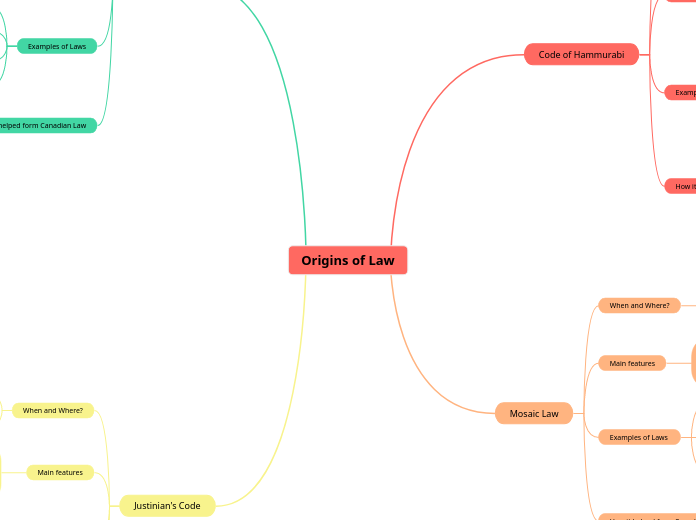Origins of Law
Code of Hammurabi
When and Where?
The Code of Hammurabi was written between 1792-1750 BCE in Babylon and was discovered by French archaeologists in 1901 in Iran.
Main features
The main features of this legal system are that the laws were all decided by King Hammurabi, these laws were made for a male dominant society and the wealthy were given more protection in the law. These laws were also made with a clear hierarchy in mind with gods at the top, then the king, male nobles, then their wives and children with the poor and slaves at the bottom. Hammurabi’s Laws were also heavily based on retribution but the strong were expected to protect the weak.
Examples of Laws
If a physician operates and kills a patient his hands will be cut off
If a man strikes a woman and she dies, the man’s daughter will be put to death
If you commit a robbery and get caught you will be put to death
How it helped create Canadian Law
The Code of Hammurabi influenced our legal system because like in the code of Hammurabi if you commit a crime you will be punished, although the punishments are not as severe as before. If you commit a crime while living in Babylon then you would go into trial in front of judges (who are there to defend the laws) who would decide your fate and we still have a trial system nowadays where laws are enforced by the court.
Mosaic Law
When and Where?
Mosaic Law was written around five hundred years at Mount Sinai after the death of Hammurabi and are the laws that are now known as the Ten Commandments in the Book of Exodus in the Old Testament
Main features
Unlike the Code of Hammurabi, Mosaic Law focuses on punishing people if they deliberately committed a crime instead of accidental acts of harm. This legal system also punished the guilty party no matter their social status and it focuses on caring for the poor.
Examples of Laws
Thou shall not kill
Thou shall not raise a false report, or put thine hand with the wicked to be an unrighteous witness (You can’t lie to the authorities and you can’t defend the guilty even if they’re close family)
Thou shall not steal
How it helped form Canadian Law
Mosaic Law influenced our legal system to focus on punishing those who deliberately committed crimes instead of accidents and introduced restitution which is compensating the victim for any crime you did. Mosaic Law also sought out to protect the innocent until they were proven guilty (if they are guilty) which is a huge part of Canada's legal system.
Roman Law
When and Where?
Roman Laws were written around 450 BCE to before 395 CE within the Roman Empire and were compiled by a group of 10 men and are seen as the foundation of modern law.
Main features
The two main principles of Roman Law are that the law must be recorded/written down and that judges cannot enforce the laws by themselves. They were originally recorded in the 12 Tablets which promoted that simple crimes would be met with public prosecution, victim compensation and that the lower class would be protected by the higher class.
Eventually, as society and crimes got more complex and the laws started growing in number it became necessary to get help from people who are experts in the law who are now our modern-day lawyers.
Examples of Laws
No burying or burning corpses in the city
No marriage between someone of the higher class and someone of the lower class.
If the owner of an item kills a thief, it is deemed that the thief has been lawfully killed
They also accepted foreigners
How it helped form Canadian Law
Roman Law was important for the development of Canadian Law because it introduced us to the rights of immigrants becoming citizens as well as automatically being a citizen of the country in which you’re born no matter your race.
Justinian's Code
When and Where?
Justinian’s Code was written after 395 CE in the Byzantine Empire when the Roman Empire split into the Byzantine Empire and the Western Roman Empire.
By 529 CE the Emperor had a new set of laws
Main features
The glory of the Roman Empire was declining so in an effort to restore and preserve it, Byzantine Emperor Justinian (527-565 CE) commissioned ten men to study Roman Law. By 529 CE the Emperor had a new set of laws that combined Roman Law with what we now know as Modern Law.
Examples of Laws
Freedom, from which men are said to be free, is the natural power of doing what we each please, unless prevented by force or by law.
Marriage, or matrimony, is a binding together of a man and woman to live in an indivisible union.
How it helped from Canadian Law
Justinian’s Code was important for the development of Canadian Law because it formed the beginning of civil laws which along with criminal law, is a part of our law system.
